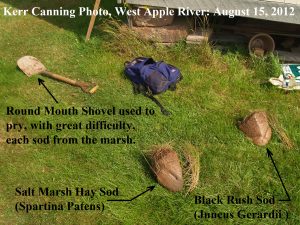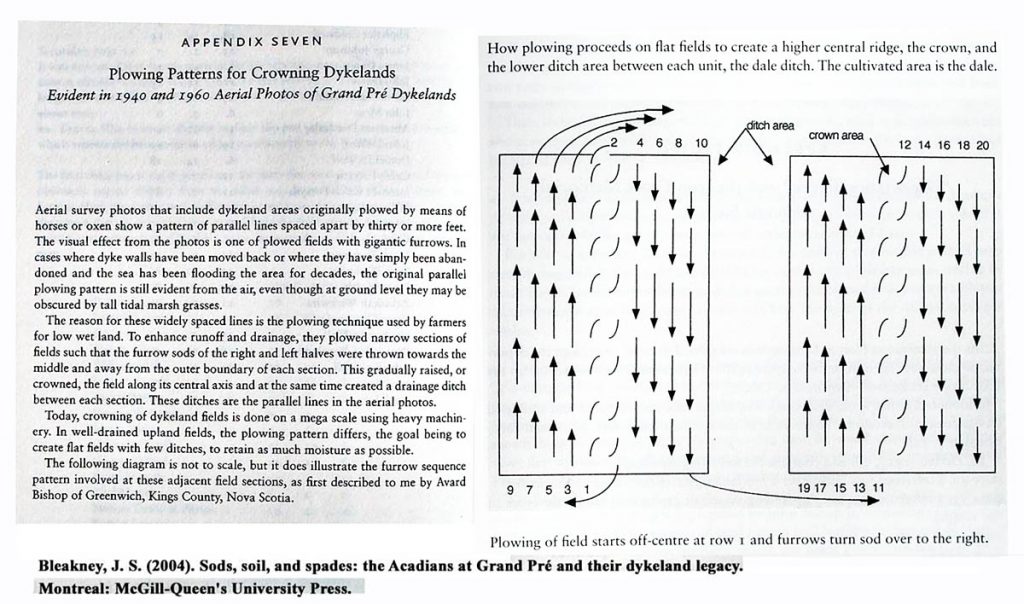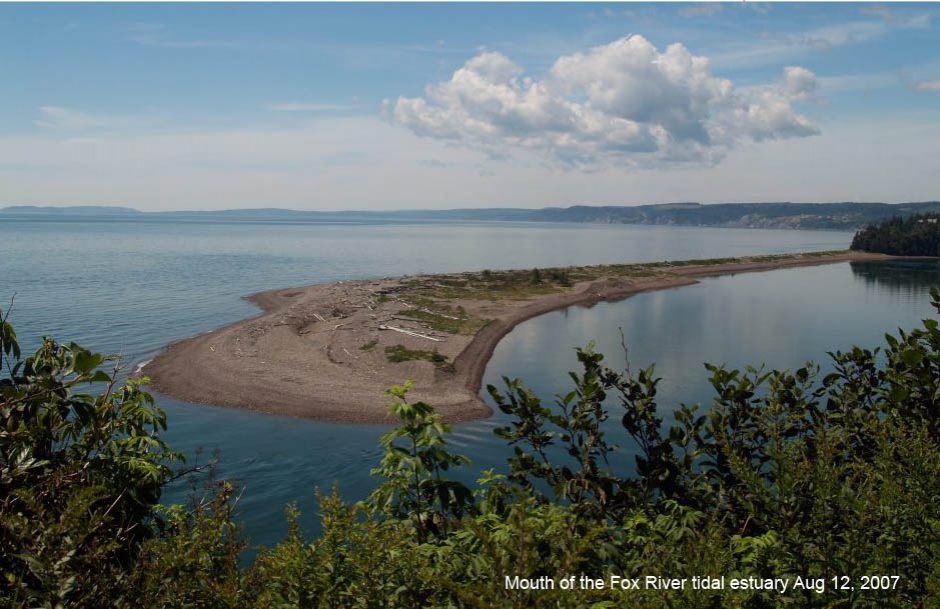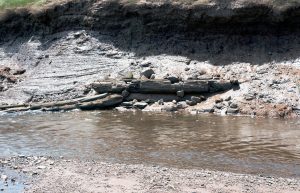On the structure of sods used to make dyke walls

The late Dr. Sherman Blakeney, author of Sods, soil, and spades: the Acadians at Grand Pré and their dykeland legacy
Understanding the physical structure of sods cut from a tidal marsh is a first step towards appreciating how dyke walls could be constructed.
One can see the intricate root structure of these sods by using a method demonstrated by Dr. Sherman Bleakney, a marine biologist. Once the sod’s nutritious soil is washed away, it is abundantly clear how the physical properties of these cut sods made them ideal building blocks for constructing dykes:

Fig 1. Salt marsh sod, unwashed and washed. The sod was cut from the upper flat section of the Apple River salt marsh where both Spartina patens and Juncus gerardii occur
Introduction
I retired in 2004 from the Physics Department at John Abbott College in Montreal and shortly after I began researching the history of dykes and aboiteaux located on several salt marshes found on the coast of Nova Scotiaís Chignecto Peninsula (Fig.1). This region of Nova Scotia’s Bay of Fundy is where I was born, grew up and return each summer. The research involved visits to archives and fieldwork on several marine marshes.
Fortunately for me, working on the tidal marshes was not a new experience. During my teenage years I roamed all over several of these marshes, exploring and looking for places to fish saltwater trout. I was familiar with the marshland landscape and the local tides. I learned to be on the lookout for objects on marsh surfaces and in river beds of water courses flowing through each marsh. These objects could be wild life or man-made structures. For an example of an unknown man-made object see Fig.2. This habit of being aware of one’s surroundings carried over to my research by allowing me to spot items of possible archaeological interest and to recognize certain salt tolerant plants from which sods suitable for building strong dyke walls could be obtained.
In 2004 which was the year I retired, I met Professor Sherman Bleakney, a marine biologist and a retired professor from Acadia University (see photo at top of this page). That was the same year that Professor Sherman Bleakney published his book Sods, soil, and spades: the Acadians at Grand Pré and their dykeland legacy. Dr. Bleakney’s book was based on research spanning close to a decade; he investigated the dyking activities practised by the Acadian settlements in the Grand Pré region of Nova Scotia. The Grand Pré salt marshes are located on the south side of the Minas Basin whereas the marshes with which I am familiar are on the north side of the Minas Basin. After reading Dr. Bleakney’s book, I started to correspond with and subsequently, visited Dr. Bleakney. I had many questions for Dr. Bleakney since I had been interviewing two elderly men who had worked on the dykes on the north side of the Minas Basin. As young men they were members of a marshland community organization that every spring repaired man made dykes
Meeting and visiting with Dr. Bleakney was both informative and inspiring. It was evident that his knowledge of biology and the history of dykes as well as his enthusiasm for the subject would influence my future studies of marshes and dykes.
Dr. Bleakney’s demonstration of the important and unusual root structure of Spartina patens and Juncus gerardii sods.
Spartina patens, a member of the grass family, and Juncus gerardii , a rush, are salt-tolerant plants that grow on the upper flat region of a salt marsh. Juncus gerardii, called black grass, borders on, or is close to the upland and Spartina patens, called salt marsh hay, grows just below Juncus gerardii (Fig.3). Of all the salt-tolerant grasses found on the Bay of Fundy marshes, it is only these two species that have a root structure that produces rigid sods suitable for building dyke walls. I am not certain but it is possible that this species restriction may apply to dyking along the entire North Atlantic coast. In Dr. Bleakney’s words, an understanding of historic Bay of Fundy dykeland agriculture is based on a knowledge of the root structure of these two plants:
…we must acknowledge the root systems of marine marsh grasses. They are the structures that figuratively and literally tie all of this cultural and natural history of dykelands firmly together. Roots spread through this nutritious soil in every direction, forming a tight tangled root matrix that resists being pulled apart. When all of the clay is washed from a marsh sod, which I discovered is not easily accomplished even with a garden hose at full pressure, a very firm replica of the original sod, consisting entirely of roots, remains…
Bleakney, J. S. (2004). Sods, soil, and spades: the Acadians at Grand Pré and their dykeland legacy. Montreal: McGill-Queen’s University Press. Page 22
A motivation factor behind the design of Dr. Bleakney’s demonstration was his concern that ìthe general literature on dyke wall construction often used the terms mud sod and marsh mud. These terms could be interpreted as meaning that it was mud that held a sod together. However, his research and interviews with former dykemen showed that ìit would be more accurate to say that the roots bond well with themselves and that the marsh mud becomes trapped in that firm, wiry, entangled matrix. Furthermore, this firm, wiry, entangled root matrix produced sods that were quite rigid objectsî that have the structural ability to make dyke walls capable of holding back high tides in order to prevent the inundation of dyked land. Dr. Bleakney believed that his demonstration would promote an understanding of how sod structure met this demanding requirement.
Further research and interviews also revealed that the entangled root matrix existed in the form of large continuous mats lying beneath the Spartina patens and Juncus Gerardii regions of a salt marsh. Several of the former dykemen interviewed by Dr. Bleakney specialized in removing sods from this mat. Because the mat could be easily sliced by a knife edged tool called a dyking spade, these specialists, called sod cutters, described a pattern they followed in removing sods from a marsh surface. The pattern had been developed based on the fact the dyking spade was cutting 4îx10îx11î sod blocks from the root mat. The time required to cut each block was approximately one minute. From his interviews Dr. Bleakney was able to deduce this pattern.
My experience reproducing part of Dr. Bleakney demonstration

Fig. 7. Spartina patens and Juncus gerardii sods removed on Aug. 15, 2012 from the section of the West Apple River salt marsh shown in Fig.4.
On the 8th of August 2012, I walked from my cottage in Apple River to a salt marsh located not far away. My goal was to repeat part of Dr. Bleakney’s sod cutting and washing experiment as outlined in detail in Chapter Four of his book Sods, soil, and spades: the Acadians at Grand Pré and their dykeland legacy. Not owning a dyking spade I brought a short handled round mouth shovel with me to cut a Spartina patens sod and a Juncus gerardii sod. To get the maximum effect from the experiment it is actually best to use a shovel to pry out, with great difficulty, muddy looking sods from the marsh. The shovel experience stands in stark contrast with using a knife rather than a shovel.
The sods I brought back to the cottage are shown in Fig.7.
In the next phase, each sod type will be cut into two pieces with one portion being washed to reveal the tight mesh of the roots. Cutting a sod involves the use of a sharp knife in order to easily slice the sod into two thin sections. This cutting is also done to appreciate the type of tool that is best suited for cutting sods. Of the two pieces, one will be washed with high pressure water. These two pieces will then be compared. By examining each sliced section, it is easy to see the intricate root structure of a Spartina patens sod and a Juncus gerardii sod. When I sliced a sod, the sensation of using the knife gave me an unexpected and somewhat disconcerting feeling. It felt as though I was slicing a piece of very tender meat. The knife passed through the sod with hardly any resistance and I quickly produced the slices shown in Fig.8. Attempting to create these slices with an ordinary round mouth shovel would have been impossible.

Fig. 9. The two sliced sections of the Spartina patens sod shown in Fig.8. One section has been washed and the other section has not been washed
Fig.9 and Fig.10 show that a high pressure garden hose can wash marsh clay from sliced Spartina patens and Juncus gerardii sods to reveal, in Dr. Bleakney’s words, ìa very firm replica of the original sod, consisting entirely of rootsî. This clearly shows that marine silt is trapped in an entangled rigid root system that has the structural rigidity required to make dyke walls capable of holding back high tides. If one handles the cut sods, you begin to appreciate the strength of the materials of these sods. In this case, you can use an

Fig. 10. The two sliced sections of the Juncus gerardii sod shown in Fig.8. One section has been washed and the other section has not been washed
agricultural pitchfork to handle the sods as a dykeman might have done when constructing or repairing a dyke. As Professor Bleakley explained it to me, the sod can be speared with a pitchfork, tossed about, and then pounded into place to become part of the waterproof brickwork of a dyke wall. Unfortunately, I did not photograph my method for establishing the rigidity of slices of the sods.
The term Parement and notes from interviewing Bernard Elliott and Chesley Knowlton
Bernard Elliott lived in Advocate, Cumberland County, Nova Scotia all of his life and Chesley Knowlton grew up in Advocate.
Sods, cut from the salt marsh with a special knife called a dyking spade, are used in the construction of dykes. On separate occasions I asked Bernard Elliott and Chesley Knowlton questions regarding the use of sods in dyke building. Both men had been part of the work teams on the Advocate dyke. To my surprise both men informed me that the term sod was not used in Advocate. Advocate used a word that sounded to me like “permong”. I had to consult Prof.Bleakney on this matter. His reply was:
“I know the word that Elliott and Knowlton were using when referring to sods. It is “parement”, an old French term for such things as facing, sleeve, curb stone. It could well refer to the surface facing sods that cover the finished dyke wall, because each one had to be precisely cut and fitted. The French pronunciation of “parement” would be very close to Knowlton’s “permong” of your e-mail. I find it very interesting that the Advocate British (are they?) retained the French terminology well into the 20th century. Is that your interpretation?”
Pronunciation
Louise Dulude, a retired Montreal French and Latin professor, told me that ìparementî is pronounced: Pa like papa; Re like Revoir; Ment like maMAN.
I also asked Bernard LeBlanc, Université de Moncton, for his comments :
Yes, “parements” is the Acadian name given to sods that covered the dykes. This is recorded in an interview by Father Anselme Chiasson with Adolphe LeBlanc of Memramcook in the late 1950s and published in Les Cahiers of the SociÈtÈ Historique Acadienne (vol. 19, no 1-2, January-June 1988, p. 52). I suspect that the English pronunciation “permong” is likely from the old Acadian French in which many words ending with the sound of an “n” (“in”, “ain”, “an”…) was pronounced with a “g”: lapin (rabbit) = laping; foin English as “LeBlong”. The surname Babin was also pronounced in English as “Babang”. Ironically, it appears that the English kept the old pronunciations whereas among the Acadians, we were taught “proper” French pronunciation in grade school.
Question from Prof. Sherman Bleakney
How was the Acadian term for sod transferred to Advocate? Did the Planter families who moved to Advocate introduce Acadian dyking methods and Acadian terminology? It is amazing that “parement” was still being used in Advocate in 2006!
Dales and Dale Ditches: Salt Marsh Drainage by “Crowning”

. Fig. 11: Photograph, taken in 2005, shows a drainage “Crown” and two “Dale Ditches” located adjacent to the so-called “Center Road” on the Advocate Dykeland. Because the permeability of a salt marsh is extremely low a way had to be found to allow rain water to run off the inclosed surface of a dyked marsh. The method devised for doing this is called “dales” or “crowning” or the more current term, “land forming”.
For dykeland agricultural to be successful effective drainage methods must be used. The Acadians improved the drainage of flat sections of their dykelands by using a special plowing procedure to construct a landform called dales (Bleakney 2004, p.78-80). Dales are long narrow rows of parallel ditches approximately 30 feet apart. The marsh between adjacent ditches is crowned to allow water to flow into the ditches that flank the crown (see Fig.11).
Sherman Bleakney, in a private communication, believes that the presence of dale and dale ditches ìimplies crops, not hay. In dykeland agricultural research dale and dale ditches are therefore important landscape features to be located. This can be done by walking over the surface of a dyke- enclosed the salt marsh or by carefully examining aerial photographs for parallel lines.
When Bernard Elliott was asked if a particular drainage method was used on the Advocate marsh he replied; yes we used dales. He also stated that “we used a special marsh plow for creating the dales. It was a Frost and Wood #6 plow and was much larger and heaver than a regular farm plow. One could bolt on a special knife to extend the cutting range and when this plow cut through the roots of black rush (Juncus gerardii ) a snapping noise occurred.î Sherman Bleakney provided the following comment on Mr. Elliottís special marsh plow.
“The plow information is very interesting, and is news to me. No one I interviewed mentioned anything about special plows, nor about attaching a special KNIFE BLADE. The knife reference is not unexpected as the dykeing sod spade also is a knife, so your new fact ties in well with the problems of attempting to plow through the root matrix of a newly enclosed parcel of tidal marsh grasses. Congratulations for discovering this gem of historic information”.
While writing “On the structure of sods used to make dyke walls” retired Canadian Wildlife Service Biologist Colin MacKinnon sent me an email outlining his knowledge of the term Parement and of the marsh plow with a special knife that extend the plow’s cutting range. Colin’s comments as well as a photograph of a marsh plow have been placed in a Comments section at the end of this web page. Colin lives in Sackville, New Brunswick and does research in Marshland/Dykeland history, regional History, Archaeology and Ecology.
In situ dyke sods exposed by erosion.
References
Bleakney, J. S. (2004). Sods, soil, and spades: the Acadians at Grand Pré and their dykeland legacy. Montreal: McGill-Queen’s University Press.
Butzer, K. W. (2002). French Wetland Agriculture in Atlantic Canada and Its European Roots: Different Avenues to Historical Diffusion, Annals of the Association of American Geographers, Vol. 92, No. 3 (Sep., 2002), 451-470
Hatvany, Matthew G. (2002). The Origins of the Acadian Aboiteau: An Environmental-Historical Geography of the Northeast. Historical Geography 30, Also available at http://www.historical-geography.net/volume_30_2002/hatvany.pdf.
Hatvany, Matthew George. 2003. Marshlands : four centuries of environmental change on the shores of the St. Lawrence, Aboiteaux of Kamouraska. Sainte-Foy, Quebec : Presses de l’UniversitÈ Laval.
Kennedy, G. M. W. (2014). Something of a Peasant Paradise?: Comparing Rural Societies in Acadie and the Loudunais, 1604-1755 Montreal and Kingston: McGill-Queen’s University Press
Kennedy, G. (2013). Marshland Colonization in Acadia and Poitou during the 17th Century. Acadiensis, Journal of the History of the Atlantic Region, 42(1), 37-66. Available at https://journals.lib.unb.ca/index.php/Acadiensis/article/view/20289/23398
Rippon, Stephen. 2000. The transformation of coastal wetlands : exploitation and management of marshland landscapes in North West Europe during the Roman and medieval periods, British Academy postdoctoral fellowship monograph. Oxford ; New York: Oxford University Press.
Rippon, Stephen, Nigel Cameron, and Council for British Archaeology. 2006. Landscape, community and colonisation : the north Somerset levels during the 1st to 2nd millennia AD. York: Council for British Archaeology.
Sebold, Kimberly R. (1992) FROM MARSH TO FARM: The Landscape Transformation of Coastal New Jersey. National Park Service, [cited 7 July 2010. Available from http://www.nps.gov/history/history/online_books/nj3/contents.htm.
Wynn, Graeme. Late Eighteenth-Century Agriculture on the Bay of Fundy Marshlands. Acadiensis, Volume 8 Issue 2 1979 [cited 15 March 2011. Available from https://journals.lib.unb.ca/index.php/Acadiensis/article/view/11501/12251
COMMENT
Colin MacKinnon, July 10, 2020:
“Interesting stuff… dyke builders here used the term, pronounced as “permang” or more usually as “permangs” for the sod blocks (when I asked how it was spelled I would get a wide range of interpretations)… My great uncle Ken Campbell would describe “cutting permangs” when he worked on dykes on the Westcock marsh. When I asked where the name came from, he really didn’t know, but suggested the French (Acadian) labourers from Minudie. I suspect, much like aboiteau was anglicized to “Bito”; the same with “permangs”. One also sees the word “Batterdeaux” on old English maps in this area for “aboiteau” location… I am not convinced that this might be another word conversion. Early English records (3rd quarter 1700’s) refer to a batterdeax as also a cofferdam… possibly the word was used by the early Yorkshire settlers as a near comparison?
“The plow as described is, or was, fairly common and the term I am familiar with was called a “breaking plow” – heavily built and usually would only cut one furrow at a time. Many of these had a “knife” (heavy sharpened bar) attached for cutting heavy soil/roots/”hardhack”. etc (see photo attached). I had one of these in my inventory when I started at CWS – used before my time to cut cattail when research was being done on impoundment draw-down and rejuvenation. We would use it on occasion to keep some fields in early stages of succession at Chignecto NWA (Amherst Point).
“I have a wrought iron sod fork (handle long gone) that was used for moving the “permangs”, although Ken told me that farmers might just as easily use a narrow, two tine, pitchfork should one of the tines get broken. The pitchfork would be modified (tines shortened) to be used as a “sod fork””
Colin MacKinnon is retired from the Canadian Wildlife Service – Atlantic Region, Government of Canada. Colin conducts research in Marshland/Dykeland history, regional History, Archaeology and Ecology.
——————————————————————————————————–
This page from Bleakney (2004) illustrates how how the plow was used to make a crown:

Also view:
Dykeland Land Forming
Kolstee H, Collette L, and Cochrane L. 2007. Atlantic Committee on Agricultural Engineering Pub No. 20 (Agdex No. 752)








